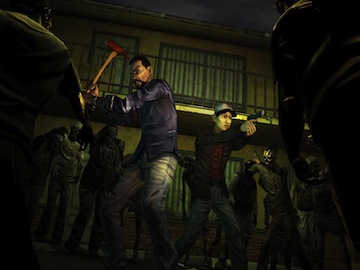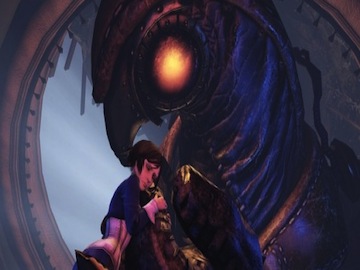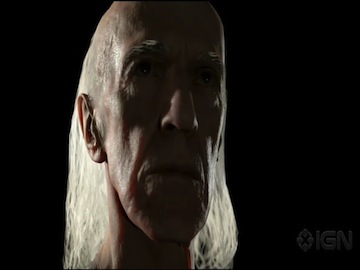I DON’T KNOW about you, but I had to inure myself to modern video games.
Joust, Ice Climber, Bubble Bobble, Ikari Warriors—the titles released during my formative years left far more to the imagination than today’s cinematic pixel-fests. Considering the fact that a new technology was only capable of so much, the majority of early games were relegated to simple puzzle-challenges, 8-Bit topiary mazes skittering with blob monsters, block-heroes, square bullets and ear-wincing sound effects. Complex storylines weren’t necessarily out of the question, but they were hard to convey with anything but splash pages of text and pixilated still shots. Until rather recently design always came first in the world of video games. Even as consoles edged into advancement and narrative arcs developed in quality, the technology of the medium compelled its tinkerers to dive further into its visual potential. This is simply the side effect of working in an industry that leans toward the illustrative end of the entertainment spectrum. For the craft’s sake, image always comes first.
A triumphant scene from the 2012 acclaimed Indie Game: Journey
When we think of storytelling these days, anyway, one of the first things we turn to is cinema. Film and television certainly surpass literature as the primary way Americans choose to imbibe their tales. Television is easy to access and endlessly enthralling, especially now as it robs Hollywood of talent to utilize it better on highbrow networks and Netflix. Although a good novel ensures a more meditative, holistic psychological experience than any good show or film, it’s hard to ignore time as one of the main deciding factors. Marathoning twelve consecutive one-hour episodes can be tempting when measured against squinting your eyes at 120,000 words. As a writer and reader myself, even I must admit the appeal of this bargain.
Modern video games, however, seem as if they’re attempting to insert themselves into our array of storytelling devices with a fervor unlike ever before. And, they’re doing a damn good job at it: Heavy Rain, Bioshock Infinite, The Last of Us, Mass Effect—all titles that feature not only brilliant visual motifs, but powerful storytelling, compelling characters, psychological gambits and pithy themes. I get lost for hours, even days, in these narratives. And I see those around me doing the same. My wife—a Walking Dead fan who doesn’t even play video games—recently spent hours watching YouTube videos of the Walking Dead game being played by a third party. The reason being, as she said:
“It’s just as good as the show.”
 As video games become more cinematic, more capable of delivering emotional experiences as opposed to limiting their terrain to puzzle solving or besting your competitor, they move closer to the realm of film itself, threatening an eclipse. The real question then is whether or not the two mediums can retain their own separate identities and continue to play nicely as they near the same horizon, borrowing from each other to the point where their boundaries begin to disappear?
As video games become more cinematic, more capable of delivering emotional experiences as opposed to limiting their terrain to puzzle solving or besting your competitor, they move closer to the realm of film itself, threatening an eclipse. The real question then is whether or not the two mediums can retain their own separate identities and continue to play nicely as they near the same horizon, borrowing from each other to the point where their boundaries begin to disappear?
As a child, most of the differences I noticed between games and film were based on the degree to which they could successfully reflect reality. Playing Pitfall, while fun, just couldn’t make you feel like Indiana Jones, no matter the scale of your imagination. Eye of the Beholder and other first-person action Role Playing Games, while benchmarks of the genre, resembled less Skyrim and more Skyfox. Therefore, whenever I sat down to play a game in 1987, I felt as if I was doing just that: playing. Early gaming technology just didn’t have the means to measure up to what was happening elsewhere in the entertainment world. It certainly wasn’t capable of rendering the accuracy of a well-drawn cartoon. When I first played Who Framed Roger Rabbit? on the Nintendo, for instance, after seeing and liking the movie, I remember feeling deeply disappointed. Even the cartridge itself, illustrated with a scene from the film, served as cruel commentary on the broken 16-Bit promise within.
The funny thing about gaming, however, is that if you dissect it to the bone, you’ll discover that the idea behind is not all that different from the idea behind film. Mainly, to carry the viewer/player through a visual experience that culminates in a meaningful entertainment experience.
For this reason I find that a lot of new movies are now exhibiting game-like qualities. Interactivity is becoming the norm, and evidence for such can be found in the resurgence of 3D glasses and the proliferation of computer renderings of high-dynamic action sequences that often overshadow substance. One need only look to video games like Killzone, Resistance, Crysis, or Gears of War to see how gaming’s influence has petered into other forms of visual media. And not always in a healthy manner. If a film is too much like a game, an audience will be dissatisfied because of the simple fact that they can’t actually play it. The Silent Hill and Resident Evil adaptations are good examples of games that can’t be played. They exhibit far too much of a reliance on the mechanics of the environment, and not nearly enough on the characters that inhabit it, their pathologies and worldviews. The same goes for films like Battleship, Transformers and Battlefield Los Angeles, whose concentration on computer-generated ephemera seems more similar to carnival rides, digital roller coasters, rather than meaningful narratives. If there’s no button to push, then all you are is an observer who wants badly to participate. Even a bad video game gives you a turn.
Other films provide better examples of this newfound relationship. While watching Pacific Rim recently for instance I found myself listening to the voice of GLaDOS (short for Genetic Lifeform and Disk Operating System) in the role of mainframe computer that controls the giant robots, or Jaegers. For those in dire need of explanation, GLaDOS is the artificial intelligence mechanism and main antagonist in the groundbreaking puzzle platform game, Portal. The cold, calculated wit of this construct generated a cultural phenomenon that took hold in mainstream gaming culture. Portal’s characters and design subsequently inspired Guillermo Del Toro. So much, in fact, that he hired the voice actress for GLaDOS (Ellen McClain) to do the voiceover in his film. The character was prepackaged, capable of making a seamless translation from one medium into another. Similarly, games like Bioshock Infinite, along with both the Uncharted and Assassin’s Creed franchises, employ full-scale cinematic drama, scenes in which characters profess their inner wants, and struggle to accomplish their dreams. Infinite even delivers a finale with a meta-science fiction, time-travel bent that, in my eyes, rendered it not just a ”game” but a fine piece of speculative fiction.
 One of the many astounding still shots from Bioshock Infinite.
One of the many astounding still shots from Bioshock Infinite.
Regardless of shortfalls, much of what has happened as a result of the gaming world’s borrowing from film has been positive. With science fiction films especially, animation tools used in games have become a producer’s treasure trove.
For a long time I had a hard time considering video games as anything but outlets for stress-expulsion with colorful designs (imagine my surprise when I heard they’d be installed at MoMa!). I believe there’s a reason, anyway, that game development studios often adapt movies for consoles, as opposed to the other way around. This mimics the way in which film production studios adapt books for the screen—due to the presence of an artistic hierarchy. Blade Runner was fashioned for the Commodore 64 in 1985, and The Karate Kid for the Nintendo in 1987. Friday the 13th, Back to the Future, Dick Tracy…. There are hundreds more. Most film-to-video game adaptations have leaned towards failure in terms of industry-specific success. Not only would a classic film’s structure have to be severely warped in order to encourage the competition found in games, there’s the problem of genre. Mainstream games still tend to deal more with science fiction, fantasy and hard-boiled crime than they do with family sagas. I certainly doubt Atonement, Angela’s Ashes or Pale Fire will be adapted for the PS3 anytime soon, anyway.
I think that’s why I was so enthralled when I discovered the same voice in Pacific Rim that I’d become used to in Portal. I was amazed at how far game creators had pushed the boundaries of their craft, attracting the attention of filmmakers, actors and an industry rife with history and talent. In the case of Pacific Rim, GLaDOS’ character could pretty much just be lifted from the game world into that of the film world, much like an actor. Superstars are doing game voice-overs all the time. Patrick Stewart played Emperor Septim in Elder Scrolls IV: Oblivion. Brian Cox was in both Killzone and Killzone 2. Billy Bob Thornton and the now departed Dennis Hopper combined talent in Deadly Creatures on the Wii. Liam Neeson played the main character’s father in Fallout 3, and Samuel L. Jackson voiced the game adaptation of Afro Samurai. Gary Oldman, Seth Green, Ron Perlman, George Takei. Each delivers his/her lines with conviction, strengthening game play with respectable apt. In this way, this joystick-derived industry is doing something that film never could. By attempting to marry narrative with play they are adding a new dimension to storytelling.
When the PS4 was revealed recently to an auditorium of astonished gamers, the world was introduced to the future of the industry. Currently being touted as the ”Creative Machine,” its pioneers showcased some of Sony’s astonishing capabilities. This machine would appeal to the booming world of indie gaming, offbeat and often experimental titles released by boutique developers. It would offer improved social platforms, liberal digital licensing, motion detection, and hardware that would enable resolution, speed, and movement unlike anything the world has seen. I found Quantum Dream’s Old Man’s Head the best presentation of the evening. This display simply consisted of an old man’s head being projected on a giant screen, and a video performance that simulated the amount of Poly Counts, or facial movement response points, that could be articulated. The spectacle was immense. The industry has evolved from pixilated blocks and blaring synthesizers to animation so real it can reach out and shake your hand. In a demonstration of how far things had come, the old man’s brow furrowed, brightened, crossed, lifted, in manners so minute it was like a cadaver brought to life. His face was blemished in an astonishingly human manner. I imagined playing a game with such a character, having him speak and interact with me. Though I must be honest, the feeling I got was tinged with horror. How will game design, and more importantly, game play, be affected by the ability to achieve such likeness to the natural world? If the genre gives in to its increasing tendency to share in the same tropes, effects and story arcs as film, will the medium I loved since I was a child become impossible to recognize?
 I’m sure that as games evolve, such changes will take getting used to. Eventually I imagine games becoming an amazing tool for real-world applications through which humans can alter aspects of their reality. I don’t think we’ve unlocked the genre’s potential yet by a long shot. Look at where film is roughly a hundred years after it shocked carnival goers, convincing them they were about to be hit by a train. A gamer today – especially an average one like myself – will likely be unconvinced of the future until it is here. But I do think it’s important to remember one’s roots. Multiple mediums can and will collaborate, but they should never fail to remember their past once in a while. Being separate but equal is where true potential is unlocked, impacting the future of creativity. The novel has properly maintained its place and importance in contrast to the popularity of film. There’s a reason why people often find film adaptations of brilliant books lackluster and insufficient. Because one can simply go where the other cannot, and that’s a good thing for the future of entertainment.
I’m sure that as games evolve, such changes will take getting used to. Eventually I imagine games becoming an amazing tool for real-world applications through which humans can alter aspects of their reality. I don’t think we’ve unlocked the genre’s potential yet by a long shot. Look at where film is roughly a hundred years after it shocked carnival goers, convincing them they were about to be hit by a train. A gamer today – especially an average one like myself – will likely be unconvinced of the future until it is here. But I do think it’s important to remember one’s roots. Multiple mediums can and will collaborate, but they should never fail to remember their past once in a while. Being separate but equal is where true potential is unlocked, impacting the future of creativity. The novel has properly maintained its place and importance in contrast to the popularity of film. There’s a reason why people often find film adaptations of brilliant books lackluster and insufficient. Because one can simply go where the other cannot, and that’s a good thing for the future of entertainment.




Thanks to The Last Of Us, every time I see Ellen Page I instinctively grab the nearest deadly weapon and move to protect her. Go time.
I’m amazed at how many authors are turning to authoring games now too. In the UK Alex Garland’s game Enslaved: Odyssey to the West was packaged with his novel The Tesseract. It was hard to imagine who might enjoy them both side by side. But there’s definitely a new market for narrative-based games that simply wasn’t there before.
Enslaved was the business. The first time I didn’t want to change to characters name, cuz who doesn’t want to be named Monkey?
Pingback: Separate but Equal: Film and Gaming — The Good Men Project
It is not better to select high-heeled shoe, if
you are an obese. They are going to almost any extent to look good and attractive.
Moccasin UGG slippers are quite popular among the men.